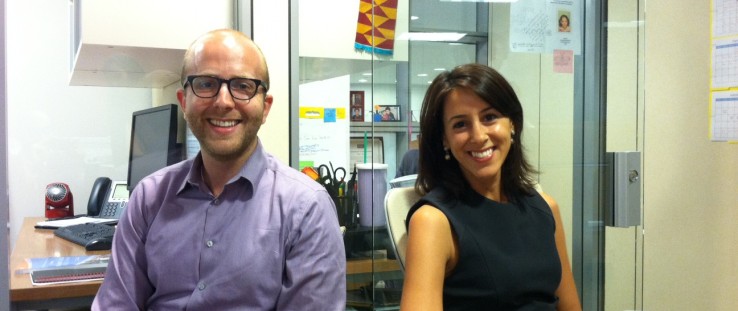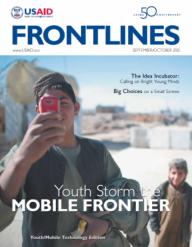 Priya Jaisinghani and Charley Johnson
Kamyl Bazbaz, USAID
Priya Jaisinghani and Charley Johnson
Kamyl Bazbaz, USAID
 Priya Jaisinghani and Charley Johnson
Kamyl Bazbaz, USAID
Priya Jaisinghani and Charley Johnson
Kamyl Bazbaz, USAID
The mobile phone sitting in your pocket has more computing power than the first computer, and all of NASA in 1969 when it sent two men to the moon. As mobile technology becomes faster, cheaper, lighter, smarter and truly ubiquitous, the possibilities are difficult to imagine.
If Moore’s Law—that computer power doubles every 18 months—holds true, the cell phone your children or grandchildren will use in 25 years will be 1 billion times more advanced than your smartphone. While it might be impossible to peer into the future, we don’t have to look far to see the impact of mobile technology in our lives.
The speed of mobile phone adoption is unprecedented. It took the radio 50 years to reach an audience of 50 million people. It took the television 13 years and the Internet seven years to meet this mark. It took the mobile phone three years.
Today, there are nearly 6 billion mobile phone subscriptions worldwide. This has transformed how we connect to one another, collaborate and communicate. You only have to think back to the last time you left your mobile phone at home to realize how deeply we depend on our devices. But the degree to which mobile technology influences our daily routine pales in comparison to its transformative impact on development.
Just as roads, railways and the Internet transformed markets and unleashed waves of innovation, mobile technology is radically changing how the world’s poor interact with one another, the private sector and their governments. It has created a platform for new ideas, new business models and new modes of communication and collaboration. Already, mobile technology has lowered the barrier of entry for the private sector and a cavalry of eager entrepreneurs to provide commercial applications like mobile money and mobile information services to farmers, mothers and small businesses.
These applications benefit from scale. In Africa, there were 49 million mobile phones in 2002. Fast-forward nine years to today: there are 500 million. By 2016, there will be an estimated 1 billion mobile phones in Africa. This represents a powerful opportunity to re-imagine how USAID works—from who we partner with to how we design, implement and evaluate programs—or risk wasting perhaps the greatest opportunity of our generation.
Mobile Technology Across USAID Programs
The connective power and ubiquity of mobile technology can accelerate and deepen development outcomes. In this issue of FrontLines, you will see examples of this.
Mobile money, for example, has the power to do for entrepreneurship what commercial banking did for the industrial revolution. But mobile money is struggling to scale in most countries. In order to drive widespread adoption of mobile money to replace physical cash, our development programs—from agriculture to health to infrastructure—should more aggressively encourage use of mobile payment services.
In Kenya, roughly 1,000 innovative businesses exist because they integrated with the pioneering mobile money transfer service M-PESA to lower costs enough to extend critical services to people in remote areas. In other words, if we’re successful in this effort, we can fundamentally change our approach to service delivery, shifting the question from ‘how can we effectively deliver services?’ to ‘how can we enable others to run us out of the service delivery business?’
You will also see that promoting mobile solutions requires a new set of partnerships and new ways of working with the private sector. The global mWomen initiative is a partnership between USAID, VISA, the Cherie Blair Foundation, and GSMA, the association of over 800 mobile phone companies worldwide. You might think that mobile phone companies would be able to close the prevailing gender gap—300 million fewer women have phones than men—on their own. They’re not. In fact, donors like USAID worked with mobile network operators to lower cultural barriers to women’s ownership, to design products and a marketing toolkit targeted toward underserved women, and to bring women into the retail stream of the mobile value chain. The mWomen initiative has shown that honest dialogue and negotiation with private sector players can lead to meaningful, high-impact outcomes.
USAID’s Mobile Solutions team turns one year old this September. As we reflect on the last year, we’re excited about how far we’ve come. In mobile money, we are working with nine missions to develop distinct mobile money programs, partnering with Citigroup to accelerate mobile money ecosystems, and creating the Better Than Cash Alliance, a coalition of corporations, international development organizations and governments that will commit to transitioning from cash to electronic payments in their programs and operational processes.
In mobile access, we are working with the mWomen initiative to close the gender gap in access to mobile phones, the Alliance for Affordable Internet to reform regulatory policies to ensure people with access to broadband can afford to use it, and the Global Broadband Initiative to assist universal service funds to expand the reach of broadband to off-grid locales.
This work, together with important initiatives like mFarmer, mEducation Alliance and the Mobile Alliance for Maternal Action, makes USAID a leader in mobile solutions.
We’re even more excited about the year ahead.
If we re-imagine how USAID does business—if we integrate mobile technology across our programs, as well as identify and leverage new partnerships—then the accuracy of Moore’s Law will not matter. The potential impact of our work will indeed be limitless in its scale and unmatched in its pace.
Priya Jaisinghani is director of mobile solutions in USAID's Office of Innovation and Development Alliances, where Charley Johnson is a presidential management fellow.











Comment
Make a general inquiry or suggest an improvement.